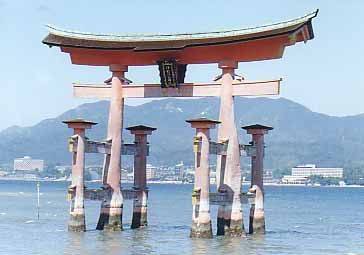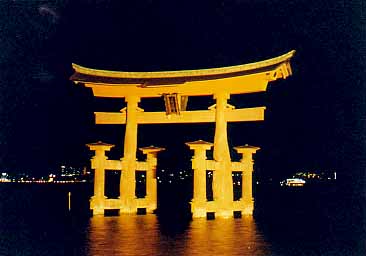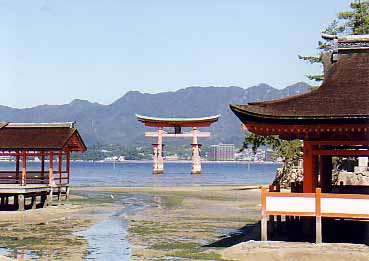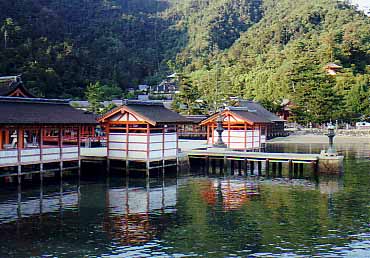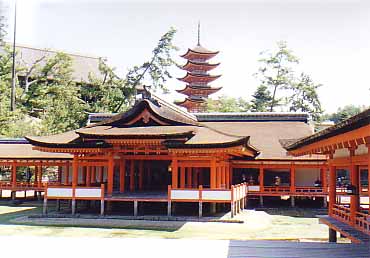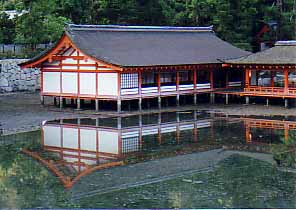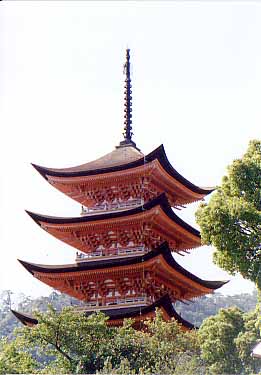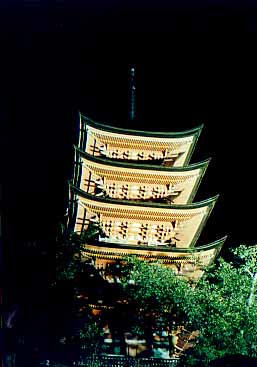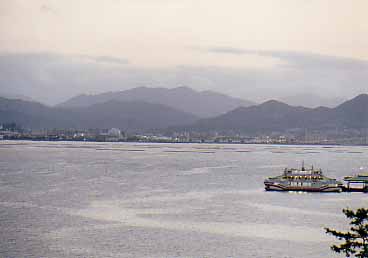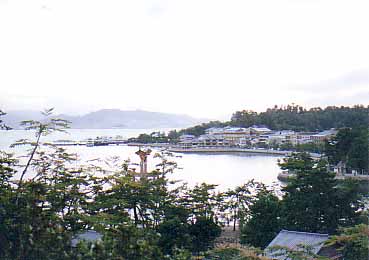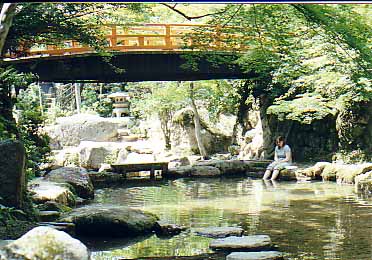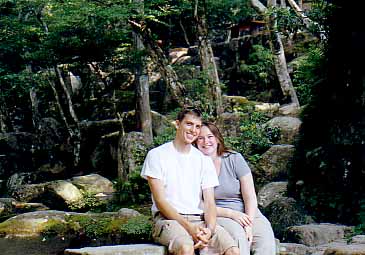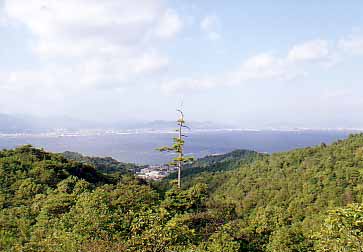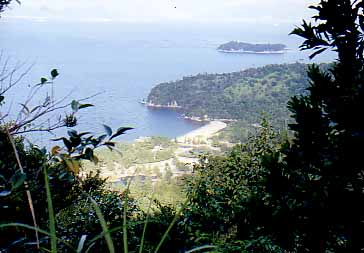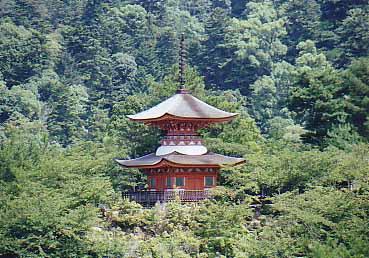
| Main Page |
| Photo Galleries |
| Writing |
| Aikido |
| Zen |
| Peeps |
| Links |
| Contact |
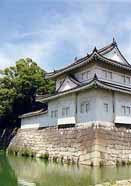
 Miyajima
Island
Miyajima
Island
 Miyajima
is a small, mountainous island smack in the
middle of Hiroshima's horseshoe shaped bay.
It is home to a great many cultural treasures,
and is said to have one of the three 'best views'
in the whole country.
Miyajima
is a small, mountainous island smack in the
middle of Hiroshima's horseshoe shaped bay.
It is home to a great many cultural treasures,
and is said to have one of the three 'best views'
in the whole country.
|
The 'Big Holiday' at our second campsite. This open-air sunshade is to tents as a fig leaf is to clothing. We were consoled by the fact that it did little to block out the breathtaking view in the valley below. |
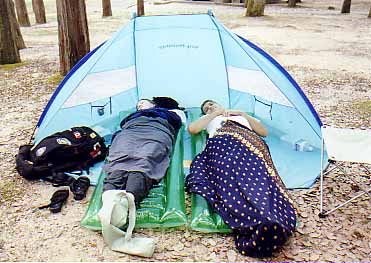 |
|
Laura (right) waking up to music blaring over loudspeakers. That's right, Japanese campsites have an early morning alarm. Note that Laura seems to have been less than thrilled with her first night in the 'Big Holiday'... freezing her butt off and getting nibbled by deer. |
The Lonely Planet states that although it is spectacular, there is no cheap way to stay on the island overnight, but this is not entirely correct. It's all a matter of lowering your standards. On this, I consider myself an expert.
Laura and I picked up all of our 'camping equipment' from the department store for about $60: an open faced sunshade tent named "Big Holiday", two inflatable mattresses and a folding chair.
Admittedly, the 'tent' was bought just so that when we left our stuff somewhere, it would look like people camping, not like a heap of junk left in a field. Really, it just made us feel like hobos. But then, that could have had something to do with the fact that after freezing to death the first night, we bought tablecloths to use as blankets for the second...but I digress (I won't mention that on the second night a typhoon just missed us).
We had many incentives to ditch our first campsite, as well. Two main reasons: First, when Japanese people camp, they seem to enjoy adding to the outdoor experience by toting along crates of fireworks. Second, proper Japanese campsites seem to come equipped with an alarm, which blares marching music over loudspeakers just before sunrise. Also, being around so many people with proper camping equipment made us feel like the bums we so closely resembled.
After scouting around the first day, we found a little out of the way place to camp up on a ridge which overlooked the whole island, and all of the bay. No alarms, no fireworks, and on a steep enough incline that there would be no deer sniffing us throughout the night (although there was a weasel).
You might ask, why, if
it's so much trouble, would we want to stay
overnight? One reason is that it gives you the
chance to see the island when it's not thronging
with tourists. The other reason is that although
the 'best view' is incredible in the daytime,
it is arguably better at night.
|
Here it is; one of the best views in the country. This giant gate marks the entrance to the Itsukushima Shrine, and boasts the mountains and Hiroshima across the bay for its backdrop. |
At night the gate is illuminated by a series of spotlights, and the lights of the city sparkle in the background. |
The gate above was used as the entrance to the Itsukushima Shrine which is built like a series of piers right out over the water. Apparently the shrine was built out over the water because commoners were not allowed to set foot on the island itself. The structure that exists today dates back to 1168, but the shrine itself was founded back in 593. All of my pictures of this shrine are on a roll of film that I forgot to develop...I'll put them up soon...they're pretty cool.
|
The torii gate lines up directly with the centreline of the Itsukushima shrine... |
...and a short pier juts out from the middle to receive seaborne worshippers. |
|
|
The shrine is made up of a number of buildings and long hallways, all raised on stilts for when the tide comes in. |
The island is literally packed with historic buildings, temples and shrines, and one of the more famous of those is the five storey pagoda shown below. Perched on a small hill next to the Itsukushima shrine, the pagoda is visible from everywhere you go, and indeed it is one of the first things you notice as you approach the island by ferry.
Another reason I can think of for staying overnight is to see the sun rise on Miyajima island. Seeing the bay so peaceful in the pre-dawn calm was truly an experience not to be forgotten. Nor will I forget seeing the morning sun cast its first rays across Mt. Misen, at whose feet we were camping, and the ancient virgin forests that cover the island.
|
Hiroshima painted in pastels: dawn on Miyajima Island. |
|
Taking ones' time also has its virtues. After taking a chance turn off the beaten path, Laura and I stumbled across one of the most beautiful places on the whole island. The 'Gourd Terrace' is a small river of extraordinary beauty which winds its way through the heart of the island, and which seems to go almost completely unnoticed by any who visit the island.
|
Laura cooling her feet in the water on the Gourd Terrace in what I believe is one of the most peaceful places on the planet. |
Laura and I soaking it all in, passing time under the bridge. |
I also learned something very important on this trip: don't try to navigate with tourist maps...they probably aren't to scale. I found all too soon when I decided to take a 'short cut' to pick up our stuff from the first night's campsite that what looked like a quick back route on the tourist map was actually a trail that led directly over top of one of the tallest mountains on the island. At least the view was good.
|
A view from on top of an unexpected mountain...it may not have been the shortest of short cuts, but the scenery was fantastic. |
Looking down on the beach that was a part of the first night's campsite. Not quite the angle I was expecting to approach from, but a cool view nonetheless. |
All told, Miyajima turned out to be an incredible place to stay. Although usually treated as a 2-hour day trip from Hiroshima in which one quickly races through the highlights and then leaves, we found this to be an ideal place to linger, and indeed it turned out to be the sort of place that only reveals its true character after one takes the time to poke around. Instead of spending only a few hours, we whiled away two nights and one and a half days.
|
The best sights on the island are only seen by those who take the time to see them. The two storey pagoda above, as seen from our campsite, and a carved wooden statue, right, in one of the island's many temples. |
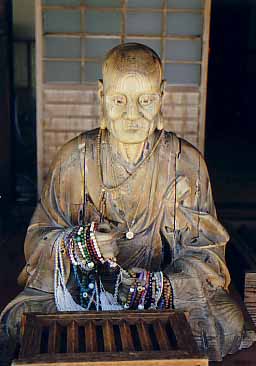 |
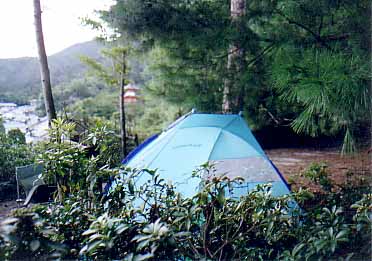
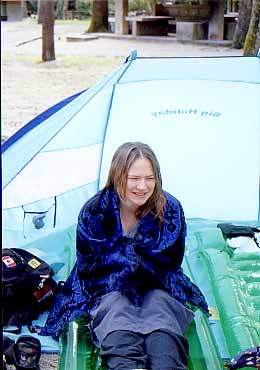 Laura
and I (above) after our first night sleeping in 'Big Holiday'...with
nothing but sarongs to keep us warm. Notice that Laura has a canvas
sack on her feet to keep them warm.
Laura
and I (above) after our first night sleeping in 'Big Holiday'...with
nothing but sarongs to keep us warm. Notice that Laura has a canvas
sack on her feet to keep them warm. 